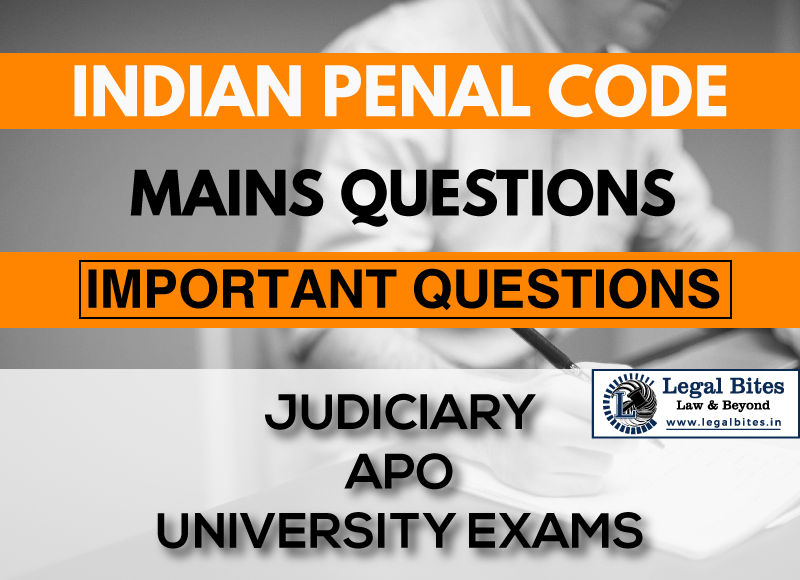A was driving a bus on a Kacha road at high speed. There were iron sheets placed on the top of the bus. On way, some of the iron sheets fell down on the head…
Question: A was driving a bus on a Kacha road at high speed. There were iron sheets placed on the top of the bus. On way, some of the iron sheets fell down on the head of B and also injured some other persons walking on the road. B was carried to the hospital by A. B died… Read More »
;Question: A was driving a bus on a Kacha road at high speed. There were iron sheets placed on the top of the bus. On way, some of the iron sheets fell down on the head of B and also injured some other persons walking on the road. B was carried to the hospital by A. B died after a month. Has A committed any offense? If so what? [H.R.J.S, 1996] Find the answer to the mains question only on Legal Bites. [A was driving a bus on a Kacha road at high speed. There were iron sheets placed on the top...
Question: A was driving a bus on a Kacha road at high speed. There were iron sheets placed on the top of the bus. On way, some of the iron sheets fell down on the head of B and also injured some other persons walking on the road. B was carried to the hospital by A. B died after a month. Has A committed any offense? If so what? [H.R.J.S, 1996]
Find the answer to the mains question only on Legal Bites. [A was driving a bus on a Kacha road at high speed. There were iron sheets placed on the top of the bus. On way, some of the iron sheets fell down on the head of B and also injured some…]
Answer:
Section 304A makes the punishable act of Causing death by negligence.— Whoever causes the death of any person by doing any rash or negligent act not amounting to culpable homicide, shall be punished with imprisonment of either description for a term which may extend to two years, or with fine, or with both.
Section 304A deals with ‘death’ caused by a ‘rash’ or ‘negligent act. . However, in both cases, the death caused should not amount to culpable homicide. The doing of a rash or negligent act, which causes death, is the essence of section 304A which must have been caused by the accused by doing any rash and negligent act.
In other words, there must be proof that the rash and negligent act of the accused was the proximate cause of the death. There must be direct nexus between the death of a person and the rash and negligent act of the accused.
In case of Kurhan Hussain Mohd. Rangawalla v. State of Maharashtra, AIR 1965 SC 1616 the court observed that Section 304A by its own definition totally excludes the ingredients of Section 299 and 300. In order to attract Section 304A, death must be a direct result of the rash and negligent act of the accused and the act must be an efficient cause without the intervention of another’s negligence.
It must be the 'causa causes, it is not enough that it may have been the causa sin qua non. Thus where death is not the direct result of rash and negligence act on the part of the accused and was not proximate and sufficient cause without the intervention of another negligence, then offense under Section 304A not established.”
In the case in hand, the accused drove the bus on a Kacha road at a high speed. Further, the iron sheets were placed on the top of the bus without taking any precautions to avoid their fall. Therefore, driving the bus at a high speed on such a path and not taking precautions while placing iron sheets on the top of the bus amount to criminal rashness and negligence.
B died due to injuries received by him on being hit on his head with the iron sheets. Therefore, there is a direct nexus between the death of B (although took place after one month of the accident) and the rash and negligent act of A. Hence, A is guilty under Section 304A of the Indian Penal Code.
Important Mains Questions Series for Judiciary, APO & University Exams
- IPC Mains Questions Series Part I: Important Questions
- IPC Mains Questions Series Part II: Important Questions
- IPC Mains Questions Series Part III: Important Questions
- IPC Mains Questions Series Part IV: Important Questions
- IPC Mains Questions Series Part V: Important Questions
- IPC Mains Questions Series Part VI: Important Questions
- IPC Mains Questions Series Part VII: Important Questions
- IPC Mains Questions Series Part VIII: Important Questions
- IPC Mains Questions Series Part IX: Important Questions
- IPC Mains Questions Series Part X: Important Questions





